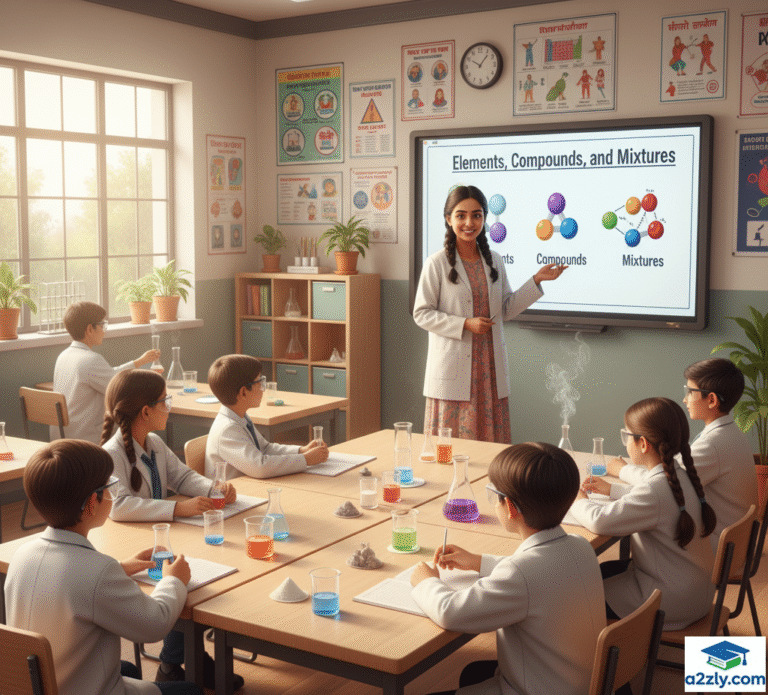🧭 Chapter Overview
Everything around us — from the air we breathe to the food we eat — is made of matter. But what is matter? What makes some substances pure and others mixed? How do scientists classify everything in the material world?
This chapter, “Nature of Matter: Elements, Compounds, and Mixtures”, helps you explore the building blocks of everything — from the simplest element to the most complex mixture.
Through hands-on activities, historical insights, and real-world applications, you’ll discover how ancient Indian metallurgists mastered alloys, how scientists classify substances, and how understanding matter helps us create innovations like graphene aerogel — one of the lightest materials on Earth.
Table of Contents
🎯 Learning Objectives (NEP 2025 Competency Format)
| Competency | Learning Outcome | NEP Skill |
|---|---|---|
| Conceptual Understanding | Explain what matter, elements, compounds, and mixtures are | Critical Thinking |
| Analytical Thinking | Differentiate between pure substances and mixtures | Analysis |
| Application | Identify mixtures and compounds in daily life | Application |
| Scientific Inquiry | Conduct simple separation and testing experiments | Practical Competence |
| Values & Heritage | Appreciate India’s contribution in metallurgy & alloys | Cultural Connection |
🔍 Section 1: What is Matter?
Matter is anything that has mass and occupies space. Everything you can see, touch, or feel — the air, water, food, clothes, and even your body — is made of matter.
However, not all matter is the same. Some are pure (made of one type of particle), while others are mixtures (combination of two or more pure substances).
🧪 Section 2: Mixtures — The Everyday Blends of Matter
Just like your poha or salad, a mixture is made when two or more substances are combined physically, without any chemical reaction.
Definition:
A mixture is a physical combination of two or more substances where each substance retains its properties.
🧩 Types of Mixtures
| Type | Description | Examples |
|---|---|---|
| Homogeneous (Uniform) | Components are evenly distributed; cannot be seen separately | Air, Saltwater, Alloy |
| Heterogeneous (Non-Uniform) | Components are visible or can be separated easily | Salad, Sand + Water, Oil + Water |
Activity Tip:
Try mixing sugar in water — you’ll see a uniform mixture. But mix sand in water — you’ll notice it’s non-uniform!
🪔 Our Scientific Heritage: Ancient Indian Alloys
Long before modern chemistry, India was crafting metallic mixtures called Mishraloha (Alloys).
Texts like Charaka Samhita and Rasaratna Samucchaya mention alloys like Bronze (Copper + Tin) used for immunity and digestion.
Even the Iron Pillar of Delhi is a historical example of India’s metallurgical brilliance.
🌬️ Is Air a Mixture?
Yes! Air is a homogeneous mixture of nitrogen, oxygen, argon, carbon dioxide, and water vapour.
Each gas retains its properties and doesn’t react chemically — making air one of the best real-life examples of a mixture.
Fun Fact:
Stainless steel is also a mixture (an alloy) made from iron, chromium, nickel, and carbon — giving it rust resistance and strength.
⚗️ Types of Mixtures (by Physical State)
| State Combination | Example | Uniformity |
|---|---|---|
| Gas + Gas | Air | Uniform |
| Gas + Liquid | Aerated water, Oxygen in water | Uniform |
| Solid + Gas | Dust in air | Non-uniform |
| Liquid + Liquid | Vinegar (uniform), Oil + Water (non-uniform) | Mixed |
| Solid + Liquid | Seawater (uniform), Sand + Water (non-uniform) | Varies |
| Solid + Solid | Alloys, Baking Powder | Uniform or Non-uniform |
💧 Section 3: What are Pure Substances?
In science, a pure substance means a material made of only one kind of particle that cannot be separated by physical methods.
| Common Meaning | Scientific Meaning |
|---|---|
| “Pure ghee” means unadulterated | A pure substance means one kind of particle only (like gold or oxygen) |
⚛️ Types of Pure Substances
Pure substances are classified into:
- Elements – made of only one kind of atom
- Compounds – made of atoms of two or more elements chemically combined in fixed ratios
⚛️ Section 4: Elements — The Simplest Substances
Definition:
An element is a pure substance made of only one kind of atom that cannot be broken down further by chemical means.
Examples: Gold, Oxygen, Hydrogen, Iron, Carbon.
Atoms of elements often combine to form molecules, e.g.
- H₂ → Hydrogen molecule (2 atoms)
- O₂ → Oxygen molecule (2 atoms)
Did You Know?
There are 118 known elements — 11 gases, 2 liquids (Mercury, Bromine), and the rest solids.
🧱 Classification of Elements
| Type | Properties | Examples |
|---|---|---|
| Metals | Shiny, ductile, conductors | Iron, Copper, Gold |
| Non-Metals | Dull, non-conductors | Carbon, Sulfur, Oxygen |
| Metalloids | Properties of both | Silicon, Boron |
🧬 Section 5: Compounds — When Elements Combine Chemically
Definition:
A compound is a pure substance formed when two or more elements combine chemically in fixed proportions.
Example:
Water (H₂O) is formed when 2 atoms of hydrogen combine with 1 atom of oxygen — properties completely different from its elements!
| Compound | Constituent Elements | Ratio | Properties |
|---|---|---|---|
| Water | Hydrogen + Oxygen | 2:1 | Liquid, extinguishes fire |
| Sodium Chloride (Salt) | Sodium + Chlorine | 1:1 | White crystalline solid |
| Sugar (Sucrose) | Carbon + Hydrogen + Oxygen | Fixed | Sweet, soluble |
🧪 Quick Experiment Connection
When sugar is heated, it decomposes to release water and carbon, proving it’s a compound (not an element).
Similarly, heating iron and sulfur produces iron sulfide — a compound with completely new properties.
🌍 Section 6: Comparing Mixtures, Elements, and Compounds
| Property | Mixture | Element | Compound |
|---|---|---|---|
| Composition | Variable | Fixed (1 type of atom) | Fixed (2+ atoms) |
| Formation | Physical | Natural | Chemical |
| Separation | Possible | Not applicable | Not by physical means |
| Example | Air, Salad | Oxygen, Iron | Water, Salt |
🔭 Section 7: Use of Elements, Compounds, and Mixtures in Daily Life
From air and water to stainless steel utensils, matter surrounds us.
Understanding it helps engineers, chemists, and environmentalists innovate — like developing:
- Graphene Aerogel: World’s lightest material from carbon.
- Alloys: For bridges, vehicles, and tools.
- Compounds: For medicines, fertilisers, and fuels.
🎨 Our Scientific Heritage: Dhokra Art of India
India’s Dhokra Art (from Bihar & Odisha) uses bronze alloys (copper + tin) to craft tribal sculptures — a living example of chemistry meeting creativity.
⚙️ Section 8: Minerals — The Natural Compounds
Minerals are naturally occurring substances found in rocks.
Some are pure elements (like gold, silver), while most are compounds (like quartz, mica, calcite).
| Mineral | Type | Use |
|---|---|---|
| Quartz | Compound | Glass & electronics |
| Calcite | Compound | Cement & lime |
| Talc | Compound | Talcum powder |
| Gold | Element | Jewellery & electronics |
🧾 Section 9: Snapshots (Quick Recap)
✅ Matter has mass and occupies space
✅ Mixtures are physical combinations retaining properties
✅ Pure Substances contain one type of particle
✅ Elements cannot be broken down further
✅ Compounds are chemically bonded
✅ Minerals are natural substances, often compounds
🧠 Section 10: HOTS (Higher Order Thinking Skills)
- Why can’t we separate hydrogen and oxygen from water by physical methods?
- How is stainless steel different from pure iron?
- Is air a homogeneous or heterogeneous mixture? Why?
- Predict what happens if the proportion of oxygen in air increases.
- What would happen if water were a mixture of hydrogen and oxygen instead of a compound?
💡 Memory Booster Box
🔹 Mixtures = Physical combination
🔹 Compounds = Chemical combination
🔹 Elements = Simplest pure substances
🔹 Alloys = Mixtures of metals
🔹 Graphene Aerogel = Lightest compound-based material
⚠️ Exam Alert Box
📝 Common Confusion: Students often mix up homogeneous and heterogeneous mixtures.
Remember: “Homogeneous = Uniform = Same Throughout.”
🪶 Section 11: NEP Competency Table
| Learning Domain | NEP Skill | Example Activity |
|---|---|---|
| Conceptual | Understanding of matter types | Mind Map on Mixtures |
| Analytical | Compare element vs. compound | Chart-based differentiation |
| Practical | Experiment (lime water turning milky) | Demonstrate CO₂ in air |
| Creative | Dhokra art alloy project | Craft-based learning |
| Ethical | Environmental awareness | Air quality discussion |
❓ Section 12: FAQs (Schema Ready)
Q1. What is the Nature of Matter in Class 8 Science?
It refers to the study of elements, compounds, and mixtures — the basic forms of matter and how they interact.
Q2. What are the three main types of substances?
Elements, Compounds, and Mixtures.
Q3. What is the difference between an element and a compound?
An element has one type of atom; a compound contains atoms of two or more elements chemically combined.
Q4. Give two examples each of homogeneous and heterogeneous mixtures.
Homogeneous – Air, Saltwater; Heterogeneous – Salad, Sand + Water.
Q5. Is air a mixture or a compound?
Air is a homogeneous mixture of gases like nitrogen and oxygen.
Q6. What are minerals?
Naturally occurring inorganic substances, often compounds like quartz or calcite.
Q7. What are alloys?
Mixtures of two or more metals (e.g., bronze, brass, stainless steel).
🔗 INTERNAL & EXTERNAL LINKS
Internal Links (A2ZLY):
- NCERT Solutions Class 8 All Subjects 2025
- AI and IoT Class 8 Study Guide
- NEP 2025 Study Material Hub
External Links:

